
Bioenergy Center Boosts Bay Area’s Prominence in Green Technology
UC Regents Approve Lab’s Development Plan
Bioenergy Center Boosts Bay Area’s Prominence in Green Technology
“For biofuels to put a real dent in our energy consumption without affecting the national food supply and without adding to carbon-dioxide emissions, we must learn to make ethanol from cellulose. Only by inventing radical new technologies will we be successful.”
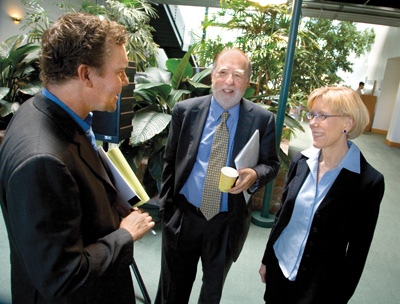
Oakland Tribune reporter Ian Hoffman (left) interviews Lab Deputy Director Graham Fleming (center) and Kristin Balder-Froid with Physical Biosciences at JBEI press conference
Thus said Secretary of Energy Samuel Bodman at a press conference following the announcement on June 26 of a massive $375 million investment in three new DOE bioenergy research centers to accelerate basic research on the development of cellulosic ethanol and other biofuels.
“I think these centers may be the most important thing we do during my time as Secretary of Energy,” Bodman said. “Where energy is concerned, we must find ways to do more with less.”
One of these three new DOE bioenergy centers will be hosted in the Bay Area through a partnership led by Berkeley Lab. This center, known as the Joint BioEnergy Institute or JBEI, (pronounced jay-bay), expects to receive $125 million in funding over five years from the Biological and Environmental Research Genomics: GTL research program in DOE’s Office of Science.
“JBEI clearly will make the Bay Area the locus for development of a green tech industry to rival the high tech and biotech industries which started here,” said Graham Fleming, Berkeley Lab deputy director and one of the principals behind the JBEI proposal. “It is a tremendously exciting day for the Bay Area and the country as a whole.”
Said Jay Keasling, director of Berkeley Lab’s Physical Biosciences Division (PBD) who has been designated as JBEI’s Chief Executive Officer: “The selection of JBEI is a major vote of confidence in the Bay Area’s growing leadership in the national effort to develop new and cleaner sources of renewable energy.”
Berkeley Lab’s JBEI partners include Sandia and Livermore National Laboratories, UC Berkeley and Davis, and Stanford University. While the initial research for JBEI will be conducted at the West Berkeley Biocenter on Potter Street in Berkeley, plans call for JBEI to eventually be headquartered in a leased building in the East Bay, central to all partners.
The other DOE bioenergy centers announced by Secretary Bodman, which also represent multi-institutional partnerships, will be headquartered at the Oak Ridge National Laboratory in Tennessee, and the Great Lakes Bioenergy Research Center, at the University of Wisconsin — Madison.
When Secretary Bodman first announced a competition for the bioenergy centers this past August, Berkeley Lab Director Steve Chu and Fleming were quick to respond. A crack proposal team was assembled, led by Keasling and including scientists and staff from all the partner institutions. The competitive process culminated in a highly successful reverse site presentation on May 31, in Crystal City, VA, before an international panel of experts.
In addition to Fleming and Keasling, the JBEI reverse site visit team included Berkeley Lab staff Chris Somerville, Paul Adams, Kristin Balder-Froid and Ellen Ford, Harvey Blanch from UC Berkeley and Berkeley Lab, Terry Michalske, Blake Simmons and Kathe Andrews-Cramer from Sandia, Pam Ronald from UC Davis, and Wolf Frommer from the Carnegie Institution, located at Stanford.
In response to the DOE announcement about JBEI, Director Chu said, “It’s an honor to be recognized by the DOE as one of the intellectual centers for the development of alternative fuels and sustainable energy. With the generous investments made by both the federal government and private industry, I’m certain that we and our colleagues in this most important endeavor will meet the challenges to transition our nation to low-carbon or carbon-free energy.”
The selection of JBEI, coupled with the selection last March of UC Berkeley and Berkeley Lab, in partnership with the University of Illinois at Urbana-Champaign, to host the $500 million, BP-funded Energy Biosciences Institute (EBI), thrusts Berkeley Lab into the national spotlight as one of the foremost institutes for alternative energy research.
While the focus of both EBI and JBEI will be on biofuels, EBI will use a bottom up “think tank” approach, which will start with individual proposals from hundreds of researchers, while JBEI will pursue highly focused goal-oriented research along the lines of a high-tech start-up company.
“JBEI’s organizational structure and culture is intended to ensure rapid commercialization of our research,” said Keasling. “Our aim is to be able to quickly pursue promising scientific and technological developments, and to seek collaborations with companies that have relevant scientific and market capabilities in energy, agribusiness, and biotechnology.”
JBEI researchers will tackle key scientific problems that currently hinder the cost-effective conversion of lignocellulose into biofuels and other important chemicals. They will also develop the tools and infrastructure to accelerate future biofuel research and production efforts, and help transition new technologies into the commercial sector. The goal is to achieve measurable success within the next five years.
As Deputy Director Fleming told one reporter, “The search for renewable fuels that won’t contribute to global warming is probably the most important thing any of us will do in our scientific lives. We’re off on a great adventure!”
UC Regents Approve Lab’s Development Plan
The Lab’s 2006 Long Range Development Plan (LRDP), which establishes a framework of land-use principles to guide the Lab’s growth and other physical development through 2025, was approved by the University of California Board of Regents on July 19.
The UC Board of Regents also certified the LRDP’s Environmental Impact Report (EIR), which provides an assessment of the LRDP and its potential effects on the environment.
The approval came at the end of a three-day UC Board of Regents meeting held at the University of California, Santa Barbara.
On the first day, July 17, Lab Director Steve Chu addressed the Committee on Grounds and Buildings concerning the growth projections outlined in the LRDP. He cited the need to revitalize the Lab’s infrastructure and to make long-term investments in new scientific facilities. For example, the Lab’s Helios program, which seeks to develop abundant, carbon-neutral, and inexpensive solar-based energy technologies, will require a modern research facility.
“But 62 percent of the Lab’s buildings are over 40 years old, many of which do not meet the Lab’s future research needs,” said Chu.
In this vein, the LRDP enables the Lab to conduct nationally important research on clean energy, computational sciences, and biosciences — to name a few — while ensuring that the surrounding community is impacted as little as possible.
Specifically, the plan projects a 612,000 gross square feet net increase in building area on the main site from 2006. In addition, the Lab’s population is projected to grow from 4,515 in 2006 to 5,375 by 2025. The plan also calls for up to 500 new parking spaces. Importantly, based on assessments of what DOE and others will likely fund, and concerns from the community, this projected growth was reduced from projections first drafted in 2003.
“We took the City of Berkeley’s concerns about traffic and the size of the Lab’s development very seriously,” said Chu.
The committee voted to approve the Lab’s LRDP and EIR. Two days later, on July 19, the full UC Board of Regents approved the committee’s report, making it official. The move caps a process that dates back to 2000, when the Lab announced it was beginning to prepare the documents. The process picked up steam this past January, when the Lab issued a draft LRDP and draft EIR. The LRDP EIR underwent a public review process that ended in late March. The newly approved documents replace the Lab’s existing LRDP and EIR, which were initially approved in 1987 (the EIR was updated in 1992 and 1997).
Lab Mathematician is ‘Caching’ in on New Outdoor Sport
For the past year, David Bailey has honed his hunting skills by trekking the oak-dotted slopes of Mount Diablo and other Bay Area hiking spots. Bailey, Chief Technologist for the Lab’s Computational Research Division’s, is a treasure hunter, but he’s not searching for buried gold or prehistoric artifacts.

Bailey at Mount Diablo State Park. (photo by Linda Bailey)
The treasure hunt — called geocaching — involves players using a portable GPS device to look for buried or camouflaged containers on public lands, from park trails to urban street corners. The containers, or caches, could be a drilled-out pinecone or an army surplus ammunition case, each holding a piece of paper for finders to log their names. Some contain CDs, toys, books or even gift cards. The caches’ coordinates are posted at www.geocaching.com, a worldwide community where players post caches they have placed or found and swap stories.
“It very much appeals to technically trained people. It’s also a nice excuse to go hiking,” said Bailey, who was introduced to geocaching last August by Howard Walter of NERSC.
Last month, Bailey won a competition to find 53 geocaches on Mount Diablo last month. Finding those caches required Bailey to take on 2,000 to 3,000-foot ascents and go off-trail, relying on his GPS device, judgment, and keen sense of direction.
On June 13, Bailey posted his last find for the game, beating his closest competitor by one full day. Posting under the screen name Mathgen, he wrote, “During the past few months, my wife and I have hiked on dozens of peasant trails, many with strikingly beautiful views that we never before knew existed. What an enjoyable, engaging and healthy avocation!”
Finding and creating caches is a brainteaser. Sometimes players have to solve puzzles to determine the coordinates. Coordinates for one of the Mount Diablo caches were written in an obscure language and encrypted with a cypher. Bailey searched the web and found a site listing numbers one through ten in thousands of languages. By analyzing letter patterns in the puzzle, he determined that the numbers were written in a Native American language and was able to recover the coordinates.
Bailey, a mathematician, also has placed more than two-dozen caches himself. One of them asks players to find the coordinates among the digits of pi, a clue that makes reference to Bailey’s well-known development of a program that can calculate any digit of pi without knowing the preceding numbers.
Geocaching can be addictive. Bailey has bagged over 400 caches since he began playing. Walter has logged 1,400, often taking detours while traveling.
“Searching for geocaches will take you to places tourists may not find on the their own,” Walter said. One cache near Sacramento was on the old Pony Express trail.
Geocaching traces its birth to 2000, when the U.S. government improved the accuracy of the GPS technology for civilians by unscrambling satellite signals previously restricted for military use. Geocaching now has a worldwide following, with more than 423,000 caches hidden around the globe.
If the Walls of Building 10 Could Talk
Building 10 was torn down last month to make way for the Advanced Light Source (ALS) user support facility. The nondescript structure was originally used as a support building for the 184-inch cyclotron, and more recently as a support building for the ALS. So what stories could the old building tell?

Calculations for Luis Alvarez's linear accelerator were scribbled on a chalkboard
After the war, Building 10 housed Luis Alvarez’s 40-foot proton linear accelerator, more commonly known as a linac. Beginning in 1946, Alvarez, Wolfgang Panofsky, and a team of specialists used surplus radar oscillators — a gift from former Manhattan Project head General Leslie Groves — to create the oscillating field that accelerated protons down the linac.
“The length of Building 10’s central bay determined the tank’s length, which in turn determined the total energy to which the machine could accelerate the protons,” Alvarez wrote in his 1987 memoir, Alvarez: Adventures of a Physicist.
A photograph of a blackboard taken on Oct. 16, 1947, reveals the final hours leading up to the linac’s success. According to a scribble written at 8:30 p.m., the search for the first beam from the linac came up fruitless. Accompanying calculations demonstrated that the machine’s geometry must be changed. Six hours later, an even more succinct note marked success: “32 MeV at 2:40 a.m.”
Sherwood Parker, a guest in the Physics Division currently working on the Large Hadron Collider, spent the summer of 1953 working in Building 10 while he was a graduate student at UC Berkeley.
“I hoped to get a really plum job running the cyclotron, but I was assigned to the linac shop instead,” says Parker. “But it turned out that working at the linac was much more useful. I had been a machine tool operator in a washing machine factory, and the additional experience in the shop resulted afterwards in my designing apparatus that could actually be built.”
The Lab hopes to break ground on the new ALS user support building in January, pending receipt of FY 2008 funding. The three-story, 32,000-square-foot building will house user-support operations at the ALS, and will include office and lab space for about 80 researchers.
Berkeley Lab View
Published once a month by the Communications Department for the employees and retirees of Berkeley Lab.
Reid Edwards, Public Affairs Department head
Ron Kolb, Communications Department head
EDITOR
Pamela Patterson, 486-4045, [email protected]
Associate editor
Lyn Hunter, 486-4698, [email protected]
STAFF WRITERS
Dan Krotz, 486-4019
Paul Preuss, 486-6249
Lynn Yarris, 486-5375
CONTRIBUTING WRITERS
Ucilia Wang, 495-2402
Allan Chen, 486-4210
David Gilbert, (925) 296-5643
DESIGN
Caitlin Youngquist, 486-4020
Creative Services Office
Berkeley Lab
Communications Department
MS 65, One Cyclotron Road, Berkeley CA 94720
(510) 486-5771
Fax: (510) 486-6641
Berkeley Lab is managed by the University of California for the U.S. Department of Energy.
Online Version
The full text and photographs of each edition of The View, as well as the Currents archive going back to 1994, are published online on the Berkeley Lab website under “Publications” in the A-Z Index. The site allows users to do searches of past articles.
Flea Market is now online at www.lbl.gov/fleamarket
Berkeley Lab Strikes NSF Gold at Homestake
“We won!” South Dakota Governor Mike Rounds told a cheering crowd of more than 300 people at a press conference in the town of Lead, following the announcement that the National Science Foundation (NSF) had selected the former Homestake gold mine just outside of Lead in the surrounding Black Hills as the site of a new national deep underground science and engineering laboratory. “This is great news for science and of course for the children of South Dakota and the region!”

NSF has chosen a team headed by Berkeley Lab’s Kevin Lesko to develop a technical design for a new deep underground science and engineering laboratory at the site of the former Homestake gold mine. (Credit: Zina Deretsky, National Science Foundation)
It was also great news for Berkeley Lab, which has been the lead institute in the multi-institutional collaboration of researchers who submitted the Homestake site proposal to NSF. There were eight sites that were originally under consideration when the competition began in 2001. The Homestake Collaboration will now receive up to $15 million over the next three years to develop a detailed design. Construction of the underground facility will take years and probably cost around $500 million, but when completed, it will be the largest and deepest in the world.
“The Homestake mine is a vast site capable of hosting a comprehensive suite of experiments in all major fields of science, including low background physics experiments, and multidisciplinary deep sub-surface studies in geosciences, geoengineering and microbiology,” said Kevin Lesko, a physicist with Berkeley Lab’s Nuclear Science Division, who has led the Homestake Collaboration since its inception. Lesko also holds a joint appointment with UC Berkeley, who submitted the Homestake proposal to NSF.
In a letter to Governor Rounds, Berkeley Lab Director Steve Chu said, “The selection of Homestake is especially rewarding for Berkeley Lab because it re-establishes the historic ties between this Laboratory and South Dakota, which was the birthplace of our founder, Ernest O. Lawrence.”
In recognition of a $70 million gift for the Homestake effort from T. Denny Sanford, owner of the First Premier Bank and Premier Bankcard Inc., and one of the country’s top philanthropists, the new deep underground research facility will be named the Sanford Underground Science and Engineering Laboratory (SUSEL).
The Homestake proposal calls for two major deep underground facility levels. One level will serve research operating from the surface down to 4,850 feet. Construction of the “Laboratory at 4850” will entail modification of an existing scientific site and preparation of new experimental chambers. The other facility is planned for the 7,400-foot depth level. A large network of existing caverns, drifts, ramps and boreholes will serve as the basis for the future construction of this second level over the next 30 years.
“The Homestake Collaboration has a lot of work in front of us before construction and we will benefit greatly from the combined efforts of all the other collaborations that competed for the site,” said Lesko.
In addition to Lesko, other Berkeley Lab researchers and staff members who contributed to the successful Homestake proposal include James Symons, Yuen-dat Chan, Nikolai Tolich, and Alan Poon of the Nuclear Science Division; Hitoshi Murayama, Michael Barnett, Stewart Loken and William Chinowsky from the Physics Division; Joseph Wang, Mark Conrad, Terry Hazen, Rohit Salve and Eric Sonnenthal of the Earth Sciences Division; Dick DiGennaro, the Homestake Project Manager from Berkeley Lab’s Engineering Division, and Dianna Jacobs from the Project Management Office.
Peidong Yang: One of Nanoscience’s Best and Brightest
In a recent interview, a prominent scientist said of Peidong Yang: “He’s become the gold standard of nanoresearch.” Anyone who has followed the meteoric rise of this 36-year-old chemist and nanoscience wizard would be quick to agree.
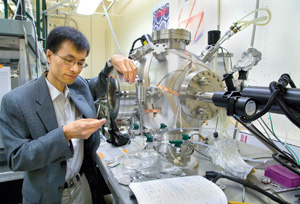
Yang working with nanowires in his lab
Earlier this year, Yang, who holds joint appointments with Berkeley Lab’s Molecular Foundry and Materials Sciences Division, as well as with the UC Berkeley Chemistry Department, was chosen to receive the National Science Foundation’s Alan T. Waterman award, a $500,000 prize that recognizes outstanding young scientists who are revolutionizing research. It was heady recognition by his peers that in the burgeoning world of nanoscience, Yang is changing the game.
Google the terms “Yang” plus “nanowires” and you will get back more than 300,000 hits. Nanowires are solid filaments that may stretch several microns in length but are only a few molecules in diameter. This high aspect ratio is but one of many unique qualities that have made nanowires a prime target of scientific investigation, and in recent years nobody has done it better than Yang. From UV light-spitting nanolasers and nanoribbon waveguides, to visible-spectrum nano light sources and silicon nanowires in living cells, Yang and his research group have blazed a dazzling array of trails.
“We’re dealing with a new class of nanostructure, so naturally there are many fundamental questions and challenges that need to be addressed,” Yang said. “For example, can we make them in a controlled manner? Do they have interesting chemical and physical properties? We’re lucky that we’re among the first groups who started to address and answer some of these interesting questions.”
Yang is originally from city of Suzhou in China, which is near Shanghai and has been called the “Venice of the East” for its beautiful system of canals. After studying chemistry at the University of Science and Technology of China (USTC), Yang came to the United States in 1993 to earn his Ph.D. at Harvard. There he studied high-temperature superconductors under Charles Lieber. He did postdoctoral research in 1997 at UC Santa Barbara, where he studied nanostructures and high-surface area silica. In seeking an academic appointment, he read about silicon “whiskers” that had been fabricated at Bell Labs in the 1960s. Inspired, he developed a research plan for nanowire fabrication, and came to Berkeley in 1999, where he became a UC Berkeley faculty member and staff scientist at Berkeley Lab. He was all of 28.
Today he has nearly a hundred publications under his belt and received numerous awards, including the Alfred P. Sloan research fellowship, the Julius Springer Prize for Applied Physics, the Materials Research Society’s Young Investigator Award, and the American Chemical Society’s Pure Chemistry Award. He also serves as deputy director at one of NSF’s Nanoscale Science and Engineering Centers, the Center of Integrated Nanomechanical Systems at UC Berkeley, and was the first chairperson for the American Chemical Society’s Nanoscience subdivision.
On a personal note, in 1996 Yang married Mei Wang, whom he met while both were students at USTC. She holds a Ph.D. in physics from Yale. In 2004, the couple had their first child, a daughter they named Rachel.
As for the immediate future, Yang has opened multiple avenues down which he might go, but photonic systems (technology based on the manipulation of light) would seem to be the logical destination for him and his research group.
“Over the past couple of years, we’ve worked heavily towards using nanowires as building blocks for the purpose of photonic applications,” he said. “Ultimately, we want to integrate all these individual components together into a photonic system-on-a-chip that could be used to perform instant and detailed analyses for studies in chemistry, biology and medicine.”
Lab Wins Three R&D 100 Awards
It was another good haul for Berkeley Lab. Earlier this month, three of R&D Magazine’s R&D 100 Awards for 2007, which recognize the 100 most significant technological advances of the year, went to Lab scientists.
The prestigious awards, known informally as the Oscars of invention, showcase the best ideas in technical innovation that were brought to market or were available for licensing during the past year. This year’s trio brings the total of Berkeley Lab’s R&D 100 Awards to 44, including two Editors’ Choice Awards, over the years. They are:
Laser-Detected MRI — a major breakthrough in the Magnetic Resonance Imaging (MRI) field that eliminates the need for a high-field magnet, making the technology accessible to new users and applications. The system uses an optical atomic magnetometer to provide much more sensitive detection. It was developed under a collaborative effort between the groups of Alexander Pines of the Materials Sciences Division and Dmitry Budker of the Nuclear Science Division. Other Lab scientists involved in developing the technology include Marcus Donaldson, Simon Rochester, Shoujun Xu, and Valeriy Yashchuk. The nomination writer was Jim Miller.

Low-swirl injector
Low Swirl Injector for Fuel-Flexible Near-Zero-Emission Gas Turbines — a technology that significantly reduces greenhouse gas emissions and pollution from gas turbines used to produce electricity, or from any stationary heating system. It was developed by Robert Cheng and David Littlejohn of the Environmental Energy Technologies Division, along with scientists from San Diego-based Solar Turbines. The nomination writer was Allan Chen.
Berkeley Unexploded Ordnance Discriminator — an electromagnetic system that can determine the location, size, and shape of unexploded buried explosives. The technology brings unprecedented speed and accuracy to the task, and could greatly reduce the time and cost of remediation and provide a valuable humanitarian service throughout the world. It was developed by several scientists and engineers from the Earth Sciences Division and the Engineering Division, including Jean-Francois Beche, Alex Becker, Larry Doolittle, Erika Gasperikova, Jim Greer, Robin Lafever, Frank Morrison, Alessandro Ratti, J. Torquil Smith, and Harold Yaver. The nomination writer was Dan Krotz.
Cheryl Fragiadakis, who heads Berkeley Lab’s Technology Transfer and Intellectual Property Manage-ment Department, says, “Winning three awards is a tremendous achievement that speaks very highly of the strength of our science and its relevance to solving complex global problems. I am particularly pleased to note that some of this year’s winners are already being further developed by partners in the private and the government sectors.”
“The Lab’s Technology Transfer and Intellectual Property Manage-ment Department, and the nomination writers, do a spectacular job and deserve to be featured prominently in the accolades,” says Pines. “The investigators are important, but these other groups make it happen, and I can testify that without these groups the awards would not be possible. The awards are a tribute not to only to Lab scientists, but to the entire Lab and to the role they play in galvanizing the interface between the Lab and the outside world.”
—Dan Krotz
‘Most Complex’ Detector Installed at CERN
The ATLAS silicon pixel detector was installed June 28th at CERN’s Large Hadron Collider in Geneva, 15 years after its conception by Berkeley Lab’s ATLAS Group. The detector’s endcaps, major elements of its support structure, and all of its internal electrical and cooling elements were designed at Berkeley Lab, with major components fabricated here.
“This is a major milestone,” says the Lab’s ATLAS Group Leader, physicist Gil Gilchriese. “The pixel detector has 80 million channels and is the most complex detector of its type every constructed.”
Gilchriese says, “In one sense, installation culminates years of invention and development, but on the other hand, a new chapter is about to begin. The operation of the detector will be tested using cosmic rays, until the Large Hadron Collider finally turns on in the summer of 2008.”
—Paul Preuss

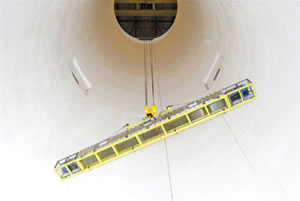
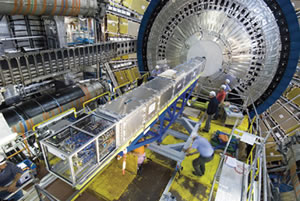
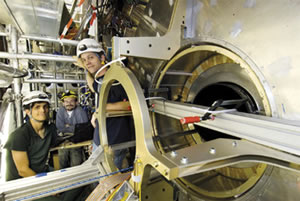
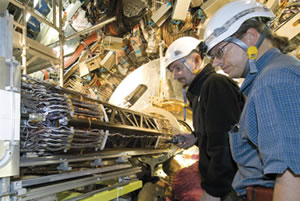
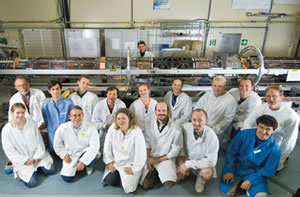
(L-R): 1) On a visit to CERN, Director Steven Chu talks with Berkeley Lab physicist Kevin Einsweiler (left), overall ATLAS Pixel Project Leader, in the clean room where the detector is being assembled. 2) The detector was lowered 92 meters underground to the ATLAS cavern, then (3) lined up for insertion into the heart of the giant experiment. 4) (From left) Tom Johnson and Neal Hartman of Berkeley Lab’s Engineering Division, and UC Berkeley physics grad student Michael Leyton, monitor the insertion, with 5) Engineering’s Eric Anderssen (left) and Einsweiler. With clearance less than a millimeter, it took two days to guide the detector into the 6.5-meter-long carbon-composite support tube in the center of ATLAS. 6) The assembly team included members from Berkeley, Italy, and the Czech Republic, pictured here, plus others from France, Germany, other U.S. institutions, and CERN. (photos by claudi marcelloni, cern)
Lease Extension Allows Growth of Bioenergy and Education Programs at JGI Campus in Walnut Creek
The DOE Joint Genome Institute will celebrate its tenth anniversary in Walnut Creek next year with a new lease and a new wing — to better accommodate the seemingly insatiable appetite for information embedded in DNA sequence, particularly from plants and microbes of bioenergy relevance.

JGI education head Cheryl Kerfeld
The latest crop of sequencing selections, including the mighty Eucalyptus tree, will serve as starting material for the Energy Biosciences Institute (EBI) and the Joint Bioenergy Institute (JBEI), as well as other collaborative efforts submitted from the growing JGI user community.
The five-year lease extension with an option for an additional five years enables JGI to expand its campus to include a vacant 18,000-square-foot building, the former Silicon Valley College/Western Career College site, which will be renovated and opened in early 2008. This addition will consolidate administrative and informatics staff and feature a new education outreach laboratory, bringing JGI’s total footprint to 80,000 square feet.
This growth coincides with the announcement of the latest portfolio of selections for JGI’s Community Sequencing Program (CSP). These plant and microbial targets — most with implications for helping wean the nation’s dependence on fossil fuel — total some 21 billion nucleotides of DNA sequence capacity for FY 2008.
Among the highest profile of these projects, and largest, is the eucalyptus tree genome — geared to the generation of resources for renewable energy — led by Alexander Myburg of the University of Pretoria, South Africa, with Gerald Tuskan of Oak Ridge National Laboratory (and JGI’s Laboratory Science Program Lead), and Dario Grattapaglia, of EMBRAPA Genetic Resources and Biotechnology (Brazil).
“A major challenge for the achievement of a sustainable energy future is our understanding of the molecular basis of superior growth and adaptation in woody plants suitable for biomass production,” said Myburg. Eucalyptus species are among the fastest growing woody plants in the world and, at approximately 18 million hectares in 90 countries, the most widely planted genus of plantation forest trees in the world. Eucalyptus is also listed as one of the U.S. Department of Energy’s candidate biomass energy crops.
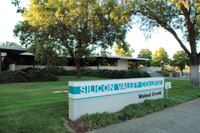
This former college will house JGI's new education center, as well as administrative and bioinformatics staff
The second largest CSP project selected for 2008 is foxtail millet (Setaria italica). Foxtail millet, a forage crop, is a close relative of several prospective biofuel crops, including switchgrass, napiergrass, and pearl millet. In the U.S., pearl millet is grown on some 1.5 million acres and is being explored as a supplement for corn in ethanol plants in regions that suffer from drought and low-fertility soils.
The marine red alga Porphyra purpurea is the third largest 2008 genome selected. The ocean plays a key role in removing carbon dioxide from the atmosphere with the help of marine photosynthetic organisms like Porphyra consuming the carbon and releasing oxygen.
JGI will also pursue eight smaller complex multicellular (eukaryotic) projects in 2008, add 54 different microbial isolate genomes to the production sequencing queue, and take on four important metagenomic projects.
To head its new education program, JGI has recruited Cheryl Kerfeld, who at her previous post at UCLA, developed and directed the Undergraduate Genomics Research Initiative. Cheryl is a structural biologist with research interests in the structural and functional characterization of bacterial microcompartments and of proteins involved in photoprotection in photosynthetic organisms.
“We conceived JGI’s new education program to help fill a void in life sciences training in areas emphasized by the 2005 National Research Council report — particularly focusing on the tools of large-scale DNA sequencing and bioinformatics,” said Kerfeld.
“We expect that the program will be useful to a range of institution types, drawing predominantly JGI’s user community of research universities and national laboratories. In addition, there’s a great opportunity to work with community colleges where faculty may be unfamiliar with bioinformatics and genome-scale research. These products also have the potential for adaptation to the high school level.”
Report from Washington: Appropriations Bill Inching Forward
Every year, Congress passes legislation that appropriates funding for the upcoming fiscal year. Currently, the House and Senate are busy debating and preparing spending bills for FY 2008. Although it is an annual process, it is typically not an easy one and this year seems to be no exception. With disagreements on how Member of Congress-sponsored projects are disclosed and with veto threats from President Bush, it could be several months before spending bills are finally passed and signed into law.

Berkeley Lab receives the majority of its funding through the Energy and Water Development Appropriations bill. The bill is one out of twelve that fund the operations and programs of the federal government. The House of Representatives is scheduled to wrap up its consideration of the Energy and Water funding legislation soon. Over the next couple of months, the Senate will pass their version of the bill and then the two houses will meet in a “conference committee” to work out differences.
The House bill includes some good news for Berkeley Lab. Most significantly, the bill contains an increase of $116,206,000 for the Office of Science above the President’s budget request and $716,788,000 above FY 2007 spending levels. The bill also provides $637,645,000 more for energy efficiency and renewable energy research and development than the President requested.
In addition to providing funds that will enable Berkeley Lab to move forward on the demolition and deconstruction of the Bevatron, the bill also provides funds for the construction of the much-needed Advanced Light Source User Support Building. Ben Feinberg, Deputy Director for the ALS applauds the action. “Given the growth in both the number of users and beamlines at the ALS, this new facility is critical to providing the high level of service and access to science for which we strive,” Feinberg said.
A committee report accompanying the House bill explains their legislative intent and includes language supportive of the Joint Dark Energy Mission. Berkeley Lab’s SuperNova Acceleration Probe (SNAP), headed by Lab cosmologists Saul Perlmutter and Michael Levi, is one of the three top competitors for this multi-hundred million-dollar dark energy program that would launch a satellite telescope to more accurately measure the expansion of the universe. The report states in part that, “Answering this question (dark energy) is among the top priorities of the physics community and of the Office of Science, and the committee strongly believes that this initiative should move forward.”
Although the Senate Appropria-tions Committee has completed its initial work on the FY 2008 Energy and Water Development bill, the full Senate has yet to consider the legislation. Staff sources predict that the bill may not make it to the senate floor in July. With the traditional August congressional recess, the bill may not pass the Senate until September.
The Senate Committee bill also includes increases for the Office of Science and for energy efficiency and renewable energy research and development. However, there are significant differences from the bill the House passed. It does, however, fund the ALS User Support Building and demolition of the Bevatron. Addi-tionally, the bill includes supportive language of the Joint Dark Energy Mission similar to the House bill. Differences in spending priorities within the Office of Science budget include computation and computing research and high energy density Physics, both of which have potential impacts on Berkeley Lab programs.
Berkeley Lab Science Roundup
Into the Depths


Left: Jim Bishop (left) and Todd Wood directed the successful test of the Carbon Flux Explorer (photos by Roy Kaltschmidt, CSO) Right: The Carbon Flux Explorer surfaces near the Research Vessel Sproul
Five years of work by the Earth Sciences and Engineering Divisions, funded by the Office of Biological and Environmental Research in DOE’s Office of Science, culminated late June in a successful test of the Carbon Flux Explorer (CFE) in waters off San Diego. The test inaugurates a new generation of robotic vehicles designed to measure particles that carry carbon from the surface to the deep sea. Diving as deep as two kilometers, operating day and night for months at a time, the CFEs will report data and positions via satellite. The new robot’s special instruments were built at Berkeley Lab, with the buoyancy engine provided by the Scripps Institution of Oceanography. Launched from the R/V Sproul the evening of June 20, the CFE dove up to 800 meters, collected over 200 photographs, and surfaced every eight hours to report to satellites overhead before an uneventful recovery on the morning of June 22. The Office of Naval Research and National Oceanographic Partnership Program provided ship time aboard the Sproul. Test leaders Jim Bishop and Todd Wood were assisted by ESD’s Alejandro Morales, Oakland High School teacher Katie Noonan, UC Berkeley undergrad Mark Cheever, and Creative Services Office photographer Roy Kaltschmidt.

Column A shows palladium crystals grown on cubic nanocrystalline platinum seeds. Transmission electron microscopy reveals the seed inside each crystal (B and C). The orientation of the internal cubic seed determines the outer shape of the crystals (D).
Crystal Seeds
Many of the physical and chemical properties of nanocrystals depend on their shape, but until now, controlling the shape of nanocrystals has largely been a trial-and-error proposition. In the July issue of Nature Materials, Peidong Yang, Gabor Somorjai, Susan Habas, and Hyunjoo Lee of the Lab’s Materials Sciences Division and the UC Berkeley Department of Chemistry, with their UCB colleague Velimir Radmilovic, report a promising new way to design crystalline nanostructures: they start with highly faceted metal crystals and grow a different kind of metal on these “seeds.” When palladium is matched to the crystal lattice of platinum seeds, the result is core-shell particles of specific faceted shapes. When the overgrown metal is not matched to the seed lattice, other shapes can be grown, such as long rods of gold.
How Kinky is High-Tc?
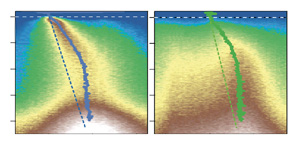
Photoemission spectra reveal high-energy kinks in the energy bands of a cuprate semiconductor
In experiments carried out at the Advanced Light Source and Brookhaven’s National Synchrotron Light Source, a team led by Brookhaven’s Tonica Valla and including Zhihui Pan and Alexei Fedorov of the ALS has discovered a kinky new feature in a pair of cuprate high-transition-temperature (high-Tc) superconductors. Valla had previously found low-energy kinks in the energy bands of cuprates at the transition temperature in 1999, but the discovery of high-energy kinks in two kinds of these materials, reported in Physical Review Letters April 20, raises new questions about the kinks’ role. Valla’s group hypothesizes that both kinds of kinks indicate spin fluctuations, when atoms flip their spins one after another as they try to align themselves. In a fashion not fully understood, spin fluctuations may be intimately connected with superconductivity.
Nanoelectronics Made Simple

Gold microdots and numbers demonstrate nanoscale printing with metal particles in solution
To build up circuitry or other structures, traditional photolithography involves many steps of coating and etching layers of different materials. Nanoimprinting lithography, however — which uses a mold incorporating nanostructures to imprint low-viscosity materials (e.g., plastics) — requires just one step. Nanoimprinting for metals has been more complicated, due to their high melting temperatures. In a recent Nano Letters, Costas Grigoropoulos of the Environmental Energy Technologies Division and his colleagues, including Heng Pan, Christine Luscombe, and Jean Frechet of the Materials Sciences Division, show how metal nanoparticles in solution can be used for direct nanoimprinting. The nanoimprint can be transformed into a conductive and continuous metal film by low-temperature nanoparticle melting, promising cheap, quick, large-area flexible electronics.
Under the Sea
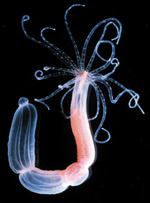
The genome of the starlet sea anemone illuminates the evolutionary origins of animals
The starlet sea anemone, Nematostella vectensis, looks primitive, and indeed it belongs to a phylum including corals, jellyfish, and hydras, the most ancient animals with digestive tracts. In the July 6 issue of Science a team led by Daniel Rokhsar and including Nicholas H. Putnam, Uffe Hellsten, Jarrod Chapman, Asaf Salamov, Astrid Terry, Harris Shapiro, Erika Lindquist, Igor Grigoriev, and Susan Lucas of DOE‘s Joint Genome Institute, along with the their colleagues in other institutions, report their surprising discovery that the sea anemone‘s genome is more like vertebrates than like flies or nematodes — and not all that far from the human genome. Other very ancient genomes may be as complex, incorporating most of the genes necessary to build today’s most sophisticated multicellular creatures.

At left, a nanowire probe causes a fluorescent bead to emit light at a specific frequency
Lighting up the Cells
Referring to what he and his colleagues call a “tunable nanowire nonlinear optical probe,” Peidong Yang of the Materials Sciences Division says they have developed the first “electrode-free, continuously tunable coherent visible light source that’s compatible with physiological environments.“ Any laser capable of emitting coherent light tunable across the visible spectrum would be an achievement, but this one is nanosized and friendly to cells, with applications ranging from medicine to cryptography. Yang and Jan Liphardt of the Physical Sciences Division, with their colleagues from Berkeley Lab and UC Berkeley’s physics and chemistry departments Peter Pauzauskie, Aleksandra Radenovic, and Richard J. Saykally, plus UCB’s Yuri Nakayama and Robert M. Onorato, report their findings in the June 28 Nature.
Perlmutter Team is Co-winner of Gruber Cosmology Prize for Discovery of Accelerating Universe
The Gruber Foundation’s 2007 Cosmology Prize of $500,000 will be split four ways by Saul Perlmutter of Berkeley Lab’s Physics Division, Brian Schmidt of the Australian National University, and members of the competing teams led by these investigators, the Supernova Cosmology Project (SCP) and the High-Z Supernova Search Team. When they announced their discovery that the expansion of the universe is accelerating, early in 1998, the two teams included most of the scientists pursuing supernova cosmology.
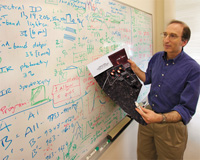
Saul Perlmutter reviews calculations of the expansion rate of the universe, based on observations by the Supernova Cosmology Project.
“It’s rare that a scientific prize is able to include a very large number of those in the community whose work actually became the underpinnings of the discovery being celebrated,” says Perlmutter, who is also a professor of physics at UC Berkeley. “Yet with the exception of a few notable contributors, that’s the case here — and that’s terrific.”
The SCP now has some 40 members in eight countries; the Gruber Prize goes to the authors of the original key papers. Many listed as members of Berkeley Lab’s Institute for Nuclear and Particle Astrophysics on the SCP paper are still at the Lab, including Greg Aldering, Gerson Goldhaber, Donald Groom, Alex Kim, and Peter Nugent.
Perlmutter and Carl Pennypacker, a guest in the Physics Division, were leading members of Richard Muller’s pioneering robotic supernova search team in 1988 when they cofounded the SCP. Pennypacker recalls “the huge skepticism of the peer group about the techniques, the team, and the underlying science. No one believed we could do it, and it was an enormous challenge to get things going.”
Goldhaber describes a “eureka moment” when the years-long struggle paid off: “We had set out to measure the deceleration of the universe, and found it was accelerating.”
These days, what accelerates the universe is called dark energy. To learn its nature will require moving into space with an instrument like SNAP, the SuperNova/Acceleration Probe.
DOD Names Joe Gray Breast Cancer Research Innovator

Gray
The Department of Defense has notified Joe Gray, Director of the Life Sciences Division, that his proposal for “Early Detection of Metastasis-Prone Breast Cancers” will receive an Innovator Award from DOD’s Breast Cancer Research Program, the world’s second-largest funding agency for breast cancer research. Gray’s proposal lays out a plan for detecting breast cancers before they metastasize, greatly improving chances of survival. Anatomic detection using MRI and PET imaging will target metastasis-prone subtypes. Scan-ning tissue sections using mass-spectrometry imaging will result in better histopathological methods. Details about the multimillion-dollar award await the working out of the final contract.
People, Awards, and Honors
Lab Chemical Scientist Gets Herschbach Award

Miller
Berkeley Lab chemical scientist William Miller has received the inaugural Dudley R. Herschbach Award for Excellence in Research in the field of the dynamics of molecular collisions. The award will be given to two recipients every year, a theoretician and an experimentalist. Miller’s research deals with all aspects of chemical dynamics, including the theory of chemical reaction and reaction rates, photodissociation, and femtosecond pump-probe spectroscopy.
Bissell Wins ‘Excellence In Science’ Award
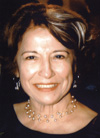
Gray
Mina Bissell of Berkeley Lab’s Life Sciences Division has been awarded the 2008 Excellence in Science Award from the Federation of the American Societies for Experimental Biology (FASEB). This award, sponsored by Eli Lilly and Company, recognizes outstanding achievement by women in the biological sciences. Bissell received the award for creating a “paradigm shift” in her conceptualization of the “dynamic reciprocity” between the cellular microenvironment, the extracellular matrix, and 3-D tissue structure in cell differentiation and cancer.
ALS Physicist Receives First Morehouse Prize

Gray
Byron Freelon has been awarded the first Morehouse Prize by the National Society of Black Physicists, which recognizes graduates of historically black colleges and universities who have shown considerable promise as physics researchers and teachers. As a Berkeley Lab postdoc at the Advanced Light Source, he studied high-temperature superconductors and developed a molecular beam epitaxy chamber. He is currently a research scientist in the UC Berkeley group led by Chancellor Robert Birgeneau exploring the behavior of high-temperature superconductors and liquid crystal systems using x-ray scattering.
Lab Employee Chosen As Regent Staff Advisor

Gray
University of California President Robert Dynes Wednesday announced the selection of William Johansen, business manager for Berkeley Lab’s Life Sciences Division, as the 2007-09 staff advisor to the UC Board of Regents. The staff advisor program allows for two staff to be selected to participate in open sessions of certain committees of the board. Staff advisors bring the voice and perspective of staff and non-Senate academic employees to board deliberations on relevant matters that come before the regents.
Berkeley Lab Wins DOE Small Business Award
Berkeley Lab was selected as one of 11 DOE facility management contractors to receive FY2006 Secretarial Small Business Awards. The “Facility Management Contractor Small Business Advancement Award” was given to the Lab in recognition of its outstanding performance for the highest overall dollars and percentage increases in small business subcontracting. The award was presented in Washington recently by Clay Sell, Deputy Secretary of Energy, and Theresa Alvillar-Speake, Director of the DOE Office of Small and Disadvantaged Business Utilization, to David Chen of Procurement, who accepted the award on behalf of Berkeley Lab.
Physicist Joins Chabot Board of Directors
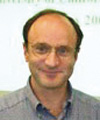
Gray
The Chabot Space & Science Center recently announced the confirmation of new members to its Board of Directors. Among them is Berkeley Lab physicist Michael Levi. Levi is the project director and co-principal investigator for the Lab’s SNAP (SuperNova/ Acceleration Probe) program. With its observatory, planetarium, exhibits, workshops, and camps, the Oakland-based center provides science education for students, teachers and the public.